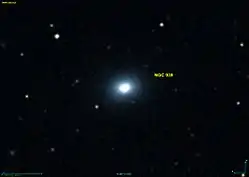NGC 939
NGC 939 is a lenticular or elliptical galaxy in the constellation Eridanus. It is estimated to be 241 million light-years from the Milky Way[3] and has a diameter of approximately 80,000 ly. NGC 939 was discovered on October 18, 1835 by astronomer John Herschel.[5][6]
| NGC 939 | |
|---|---|
 DSS image of NGC 939 | |
| Observation data (J2000 epoch) | |
| Constellation | Eridanus |
| Right ascension | 02h 26m 21.312s[1] |
| Declination | −44° 26′ 46.08″[1] |
| Redshift | 0.017186[2] |
| Helio radial velocity | 5108 km/s[2] |
| Distance | 241.4 ± 17.0 Mly (74.01 ± 5.22 Mpc)[3] |
| Apparent magnitude (B) | 14.06[2] |
| Characteristics | |
| Type | S0/a[2]/E[4] |
| Other designations | |
| MCG-07-06-004, PGC 9271[2] | |
NGC 939 is better seen from the southern hemisphere because of its location south of the celestial equator.[7]
See also
References
- Skrutskie, M. (2006). "The Two Micron All Sky Survey (2MASS)". The Astronomical Journal. 131 (2): 1163–1183. Bibcode:2006AJ....131.1163S. doi:10.1086/498708.
- "NGC 939". SIMBAD. Centre de données astronomiques de Strasbourg. Retrieved 2020-05-30.
- "Results for object NGC 0939 (NGC 939)". NASA/IPAC Extragalactic Database. California Institute of Technology. Retrieved 2020-05-30.
- "Search specification: NGC 939". HyperLeda. Université Claude Bernard Lyon 1. Retrieved 2020-05-30.
- "Revised NGC Data for NGC 939". spider.seds.org. Retrieved 2020-03-26.
- Ford, Dominic. "The galaxy NGC 939 - In-The-Sky.org". in-the-sky.org. Retrieved 2020-03-26.
- "NGC 939 - Elliptical Galaxy | TheSkyLive.com". theskylive.com. Retrieved 2020-12-04.
This article is issued from Wikipedia. The text is licensed under Creative Commons - Attribution - Sharealike. Additional terms may apply for the media files.